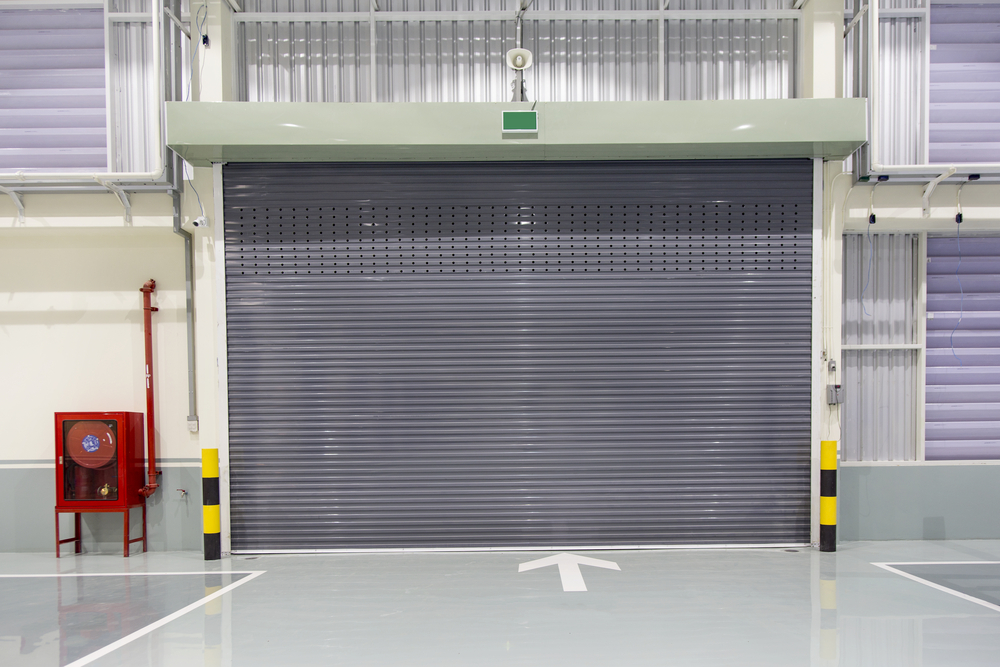We’re excited to announce that our team at Central Oregon Garage Door now includes Certified Rolling Steel Fire Door Technicians. This certification is a testament to our team’s commitment to safety and excellence, and we’re proud to offer fire door drop tests as an important service to our clients.
You may be asking, what’s a fire door? Designed to prevent the spread of fire and smoke, fire doors — also known as coiling doors or rolling fire doors — are built to automatically close when a fire is detected. They are typically found in larger buildings, such as industrial facilities, schools, hospitals, and offices. Triggered by a building’s fire alarm system or other detection devices, a properly functioning fire door delays the spread of flames during the fire, giving occupants more time to evacuate and emergency personnel more time to respond. To ensure your fire door is fully functional, it is important to perform annual testing and maintenance.
In this blog, we’ll dive deeper into the specifics of fire door drop tests — what they are, why they’re essential, and what the testing process involves. We’ll also share the National Fire Protection Association (NFPA) requirements for rolling fire door inspections and the importance of having these tests performed by certified technicians.
What Is a Fire Door Drop Test?
A fire door drop test is like a fire drill for your door—it ensures it’s ready to do its job when it counts. By simulating the conditions of a fire, this test ensures that the door will close on its own, sealing off areas to contain the blaze. The test checks a few crucial things: does the door close all the way, how fast does it shut, and are all its parts working like they should? After the test, the door gets reset twice to confirm everything’s in working order, since a faulty reset could leave you unprotected when you need it most.
During a fire door drop test, a series of steps are followed to check that the fire door is functioning correctly:
- The door is manually released to verify that it closes at the correct speed, within the time frame specified by the manufacturer and regulatory standards.
- The door’s automatic closing system is tested by simulating fire conditions, usually by activating the building’s fire alarm system or other triggering mechanisms.
- Technicians observe the door’s closure, ensuring it closes smoothly and completely without binding or obstruction.
- Any issues identified during the test are documented, and necessary repairs are recommended to restore the door to full functionality.
Fire door drop testing is just one component of the recommended annual inspection process. Referred to as a “periodic inspection,” a yearly fire door inspection includes three parts:
- A visual inspection to identify any signs of damage or wear
- Operational tests to verify that the door closes properly and at the correct speed
- A fire door drop test, as outlined above
Add it all together, and a periodic inspection covers everything you need to be sure there are no issues that could compromise your fire door’s performance.
NFPA Requirements for Rolling Fire Door Inspections
The NFPA has specific requirements for the inspection and testing of fire doors. Compliance with NFPA standards is a legal obligation and a critical aspect of maintaining a safe and functional fire protection system.
According to NFPA 80, the “Standard for Fire Doors and Other Opening Protectives,” fire doors must be inspected and tested once annually. Trained and certified technicians should conduct these inspections to guarantee compliance with standard safety regulations. During an inspection, a technician should:
- Check for any physical damage or wear that could impair the fire door’s functionality.
- Verify that the fire door’s closure mechanisms are operational and free of obstructions.
- Inspect the fire door’s seals and gaskets to ensure they are intact and capable of preventing the spread of smoke and fire.
- Confirm that the fire door’s signage is visible and legible, providing clear instructions for use during an emergency.
What Does It Mean to Be a Certified Rolling Steel Fire Door Technician?
We’re proud to say that achieving the Certified Rolling Steel Fire Door Technician designation is no small feat. This certification program, administered by the Institute of Door Dealer Education and Accreditation (IDEA), requires passing a rigorous written examination and meeting specific experience requirements. What’s more, the written examination is designed to validate exceptional expertise in installing, maintaining, and testing fire doors — not simply fundamental knowledge.
When you work with a certified technician, you eliminate the risk of improper inspections or door resets, which can lead to problems during a fire emergency. Certified Rolling Steel Fire Door Technicians are certified to:
- Install and service rolling steel fire doors with a high degree of precision and skill.
- Conduct thorough inspections and tests to ensure compliance with safety standards.
- Identify and address any issues that could compromise the door’s performance.
Technician expertise is an essential element of fire door testing and maintenance. Having Certified Rolling Steel Fire Door Technicians on our team means that we can provide our customers with the highest level of service and expertise in fire door inspections, guaranteeing that our customers’ fire doors stay in optimal condition.
Questions? We Have Answers.
We hope this blog has helped you learn more about the importance of having your fire doors inspected and tested regularly by a Certified Rolling Steel Fire Door Technician. If you have any questions about fire doors, periodic inspections, or anything else covered in this blog, don’t hesitate to reach out to our team. Our skilled and certified technicians are here to help.

